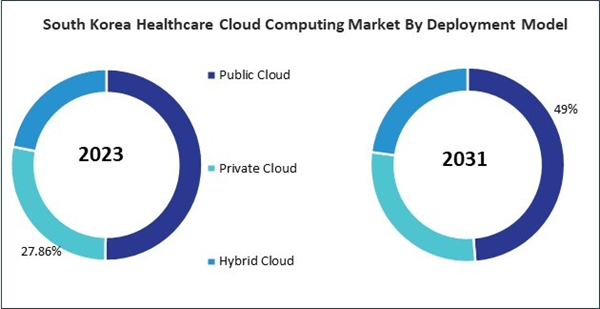The Japan market dominated the Asia Pacific Healthcare Cloud Computing Market by Country in 2023, and is expected to continue to be a dominant market till 2031; thereby, achieving a market value of $10.10 billion by 2031. The China market is capturing a CAGR of 17% during 2024-2031. Additionally, the India market would register a CAGR of 18.5% during 2024-2031.
The growing use of advanced medical imaging technologies has contributed to the rising demand for cloud solutions in healthcare. Medical imaging, including MRI scans, CT scans, and X-rays, generates large files that require significant storage capacity. Traditionally, healthcare organizations have relied on on-premise servers to store these images, but the increasing volume of imaging data has outpaced the capacity of these systems.
Cloud computing provides a scalable solution that enables healthcare providers to securely store and access medical images, as well as to share them with specialists and other healthcare providers in various locations. This improves diagnostic accuracy and treatment planning and speeds up care delivery by allowing healthcare providers to collaborate more effectively.
In Australia, the growing demand for healthcare cloud computing is largely a result of the nation’s increasing disease burden, particularly of chronic diseases such as diabetes, cardiovascular conditions, and cancer. According to the Australian Institute of Health and Welfare (AIHW), over 15.4 million Australians suffer from at least one chronic condition. To manage the data generated from chronic disease monitoring and treatment, healthcare providers are turning to cloud-based platforms that enable the real-time analysis and storage of patient information.
The Australian government’s My Health Record system, a nationwide cloud-based platform, further facilitates this trend by allowing healthcare providers to access patient data quickly and securely, improving care for chronic disease patients. Hence, the Asia-Pacific region presents a diverse and growing market for healthcare cloud computing.
Based on Application, the market is segmented into Clinical Information Systems (CIS) {Electronic Health Records (EHR), Picture Archiving and Communication System (PACS), Radiology Information System (RIS), and Others (COPE, PIS, etc.)}, and Non-clinical Information Systems (NCIS) {Revenue Cycle Management (RCM), Billings and Accounts Management Solution, and Others (SCM, HIE, etc.)}. Based on Service Model, the market is segmented into Software as a Service (SaaS), Platform as a Service (PaaS), and Infrastructure as a Service (IaaS).
List of Key Companies Profiled
- Dell Technologies, Inc.
- Hewlett Packard Enterprise Company
- Microsoft Corporation
- Oracle Corporation
- IBM Corporation
- Salesforce, Inc.
- Amazon Web Services, Inc. (Amazon.com, Inc.)
- Siemens Healthineers AG (Siemens AG)
- Koninklijke Philips N.V.
- NTT Data Corporation
Market Report Segmentation
By Application
- Clinical Information Systems (CIS)
- Electronic Health Records (EHR)
- Picture Archiving and Communication System (PACS)
- Radiology Information System (RIS)
- Others (COPE, PIS, etc.)
- Non-clinical Information Systems (NCIS)
- Revenue Cycle Management (RCM)
- Billings and Accounts Management Solution
- Others (SCM, HIE, etc.)
By Service Model
- Software as a Service (SaaS)
- Platform as a Service (PaaS)
- Infrastructure as a Service (IaaS)
By Deployment Model
- Public Cloud
- Private Cloud
- Hybrid Cloud
By End User
- Healthcare Providers
- Hospitals
- Diagnostic and Imaging Centers
- Pharmacies
- Ambulatory Centers
- Healthcare Payers
- Private Payers
- Public payers
By Country
- China
- Japan
- India
- South Korea
- Singapore
- Malaysia
- Rest of Asia Pacific
Table of Contents
Companies Mentioned
Some of the key companies profiled in this Asia-Pacific Healthcare Cloud Computing market report include:- Dell Technologies, Inc.
- Hewlett Packard Enterprise Company
- Microsoft Corporation
- Oracle Corporation
- IBM Corporation
- Salesforce, Inc.
- Amazon Web Services, Inc. (Amazon.com, Inc.)
- Siemens Healthineers AG (Siemens AG)
- Koninklijke Philips N.V.
Methodology

LOADING...









